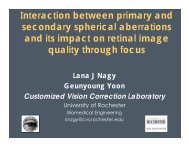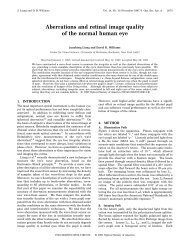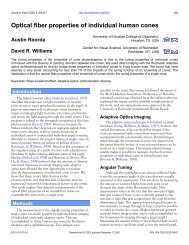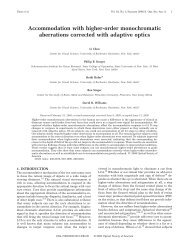Compensation of corneal aberrations by the ... - Journal of Vision
Compensation of corneal aberrations by the ... - Journal of Vision
Compensation of corneal aberrations by the ... - Journal of Vision
Create successful ePaper yourself
Turn your PDF publications into a flip-book with our unique Google optimized e-Paper software.
Artal, Guirao, Berrio & Williams 6a separate component. How this optical qualityoptimization occurs in <strong>the</strong> human eye is not clear. One canimagine ei<strong>the</strong>r an active process or that <strong>the</strong> compensation issimply a passive consequence <strong>of</strong> some random positioning<strong>of</strong> <strong>the</strong> ocular elements.The distributions <strong>of</strong> astigmatism and sphericalaberration reveal systematic patterns in <strong>the</strong> population <strong>of</strong>eyes (ie, opposite sign <strong>of</strong> <strong>the</strong> spherical <strong>aberrations</strong> <strong>of</strong><strong>corneal</strong> and internal optics [Zernike terms 5, 6, and 11 inFigure 7]). This may suggest an evolutionary process to reachan optimum balance for those aberration terms. However,o<strong>the</strong>r <strong>aberrations</strong>, such as coma, seem to distributerandomly from subject to subject, favoring a passivecompensation process or perhaps one in which activecompensation can occur during development.There are not enough precise data on <strong>the</strong> shape,location, and refractive index <strong>of</strong> every ocular component todetermine <strong>the</strong> physical basis for <strong>the</strong> compensation.However, a simple model provides a general picture <strong>of</strong> whatcould be happening in a normal, nearly emmetropic youngeye. The <strong>corneal</strong> surface has spherical aberration and acertain amount <strong>of</strong> astigmatism and comalike <strong>aberrations</strong>with orientation and magnitude varying from subject tosubject. Internal optics can be understood as <strong>the</strong> lens,which when isolated presents only spherical <strong>aberrations</strong>imilar in magnitude to that <strong>of</strong> <strong>the</strong> cornea but withopposite sign. An optical element with only fourth-orderspherical aberration generates lower-order terms (comalike,astigmatism, defocus, and tilts) when it is decentered (López-Gil, Howland, Howland, Charman, & Applegate, 1998) ortilted with respect to <strong>the</strong> axis. Small decentering and tilts <strong>of</strong><strong>the</strong> lens produce <strong>aberrations</strong> with a similar magnitude for<strong>the</strong> internal optics that we measured. This simple modelmay explain how <strong>the</strong> compensation is achieved: <strong>the</strong> lensmoves and tilts slightly to compensate in part for <strong>the</strong><strong>aberrations</strong> <strong>of</strong> <strong>the</strong> cornea. Though <strong>the</strong> eye is sophisticatedenough to maintain emmetropia <strong>by</strong> controlling eye growthduring development, it is not clear that it is alsosophisticated enough to improve retinal image qualitythrough subtle control <strong>of</strong> lens position duringdevelopment.O<strong>the</strong>r possible mechanisms could be involved in <strong>the</strong>compensation we found. One is <strong>the</strong> possible effect on <strong>the</strong>aberration <strong>of</strong> <strong>the</strong> posterior <strong>corneal</strong> surface. It should benoted that what we referred to as "internal ocular optics"also includes <strong>the</strong> posterior surface <strong>of</strong> <strong>the</strong> cornea (Guirao &Artal, 2000). The difference in refractive index between <strong>the</strong>cornea and <strong>the</strong> aqueous humor is about 10% <strong>of</strong> <strong>the</strong>difference <strong>of</strong> indexes between air and cornea. It is,<strong>the</strong>refore, unlikely that <strong>the</strong> posterior <strong>corneal</strong> surface makesa significant contribution to <strong>the</strong> <strong>aberrations</strong>. However, if<strong>the</strong> posterior surface <strong>of</strong> <strong>the</strong> cornea has a shape similar to<strong>the</strong> first surface, because <strong>the</strong> refractive index change isopposite, a small amount <strong>of</strong> first-surface aberration couldbe compensated. Precise measurements <strong>of</strong> both <strong>corneal</strong>surfaces would allow determination <strong>of</strong> <strong>the</strong> posteriorsurface's exact role in <strong>the</strong> <strong>aberrations</strong>. A decentration <strong>of</strong> <strong>the</strong>eye's pupil could also explain part <strong>of</strong> <strong>the</strong> balance obtainedbetween cornea and internal surfaces. If both <strong>corneal</strong> andocular <strong>aberrations</strong> were measured with respect to <strong>the</strong> eye'spupil and this were decentered, we could expect a comaaberration produced <strong>by</strong> <strong>the</strong> spherical aberration <strong>of</strong> <strong>the</strong>cornea and also a coma with opposite sign produced <strong>by</strong> <strong>the</strong>spherical aberration <strong>of</strong> <strong>the</strong> internal surfaces. However,<strong>corneal</strong> <strong>aberrations</strong> were measured with respect to <strong>the</strong><strong>corneal</strong> pole; in <strong>the</strong> subjects studied, <strong>the</strong> <strong>corneal</strong> pole and<strong>the</strong> center <strong>of</strong> <strong>the</strong> pupil were close enough that we did notanticipate an effect as large as we observed. O<strong>the</strong>r types <strong>of</strong>misalignments between <strong>the</strong> optical elements <strong>of</strong> <strong>the</strong> eyecould work similarly, and might explain <strong>the</strong> compensation.To investigate whe<strong>the</strong>r a random distribution <strong>of</strong><strong>aberrations</strong> in <strong>the</strong> crystalline lens could <strong>by</strong> chancecompensate for <strong>the</strong> <strong>corneal</strong> <strong>aberrations</strong>, we simulated 1000lenses with random coma (magnitude and orientationnormally distributed). We ma<strong>the</strong>matically coupled <strong>the</strong><strong>corneal</strong> <strong>aberrations</strong> <strong>of</strong> each subject with those <strong>of</strong> <strong>the</strong>randomly aberrated lens. The normally distributed comavalue in <strong>the</strong> lens that produces a larger compensation is <strong>the</strong>one with standard deviation equal to <strong>the</strong> average <strong>corneal</strong>coma. Even for this case, we did not find any instance <strong>of</strong> areduction in <strong>the</strong> total aberration <strong>of</strong> <strong>the</strong> eye. Thesecalculations showed that <strong>the</strong> compensation between corneaand lens could not be attributed to purely randomprocesses.Although <strong>the</strong> number <strong>of</strong> subjects in this study isrelatively small, <strong>the</strong> negative correlation found in Figure 9represents a statistical argument in favor <strong>of</strong> <strong>the</strong>compensation for each <strong>of</strong> <strong>the</strong>se <strong>aberrations</strong>. The balance <strong>of</strong><strong>aberrations</strong> between <strong>the</strong> cornea and <strong>the</strong> internal optics thatwe found in this study may explain some facts that are notwell understood. One example is <strong>the</strong> optical performance<strong>of</strong> eyes after implantation <strong>of</strong> intraocular lenses. Theselenses have extremely good image quality when measuredin an optical bench, but <strong>the</strong> final optical performance in<strong>the</strong> implanted eye is lower than expected (Artal, Marcos,Navarro, Miranda, & Ferro, 1995). Clearly, <strong>the</strong> idealsubstitute for <strong>the</strong> natural lens is not a lens with <strong>the</strong> bestoptical performance when isolated, but a lens designed tocompensate for <strong>the</strong> <strong>aberrations</strong> <strong>of</strong> <strong>the</strong> cornea (Figure 12).This result has important implications for ophthalmicapplications. To maximize <strong>the</strong> quality <strong>of</strong> <strong>the</strong> retinal image,intraocular and contact lenses should be designed with an







